One of the nice things about Hilton Pond is that it's big enough to attract the attention of waterfowl and many other birds that frequent aquatic habitats. At various times during the year we get everything from Canada Geese to Wood Ducks, Belted Kingfishers to Louisiana Waterthrushes, Pied-billed Grebes to Spotted Sandpipers. We've even hosted numerous species of wading birds, including juvenile Great Egrets and Little Blue Herons that show up during post-breeding dispersal. Cattle Egrets, Tricolored Herons, and White Ibises have been spotted on the property or overhead, and we're privileged to have one or two breeding Green Heron pairs each summer. One of the most common waders, however, seldom shows up until winter, when we're always delighted to see a long-legged, long-necked, long-winged bird gliding along the surface of Hilton Pond before it gracefully settles down on a muddy bank or--as happened this week--on top of a Wood Duck box. The big bird in question is a lanky grayish one that goes by name of Great Blue Heron.
Indeed, to the distant observer Great Blue Herons don't look blue at all, but a close view reveals they sport all sorts of other colors: Orange bill, yellow iris, white head with black plumes, cinnamon thighs, black-streaked fore-neck, buffy hind-neck, black legs and feet, and--of course--a blue-gray body and wings with a hint of metallic sheen. A white morph--the so-called "Great White Heron"--occurs in saltwater habitats in south Florida.
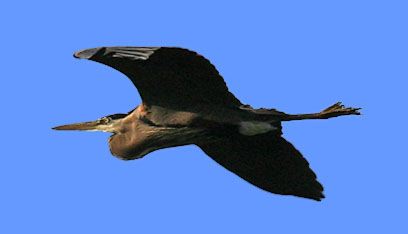 Although Great Blue Herons are sometimes erroneously called "blue cranes," members of the Crane Family (Gruidae) fly with necks outstretched, while a heron or egret (Ardeidae) folds its neck into an S-shape and holds its head close to the body (above right)--long legs trailing behind as it flaps steadily and strongly. Only at take-off and landing does the heron extend its neck (below left), likely in an effort to maintain balance at those precarious times as it glides through the air on its six-foot wingspan.
Although Great Blue Herons are sometimes erroneously called "blue cranes," members of the Crane Family (Gruidae) fly with necks outstretched, while a heron or egret (Ardeidae) folds its neck into an S-shape and holds its head close to the body (above right)--long legs trailing behind as it flaps steadily and strongly. Only at take-off and landing does the heron extend its neck (below left), likely in an effort to maintain balance at those precarious times as it glides through the air on its six-foot wingspan.
Great Blue Herons are just as at home on saltwater mud flats as they are at freshwater spots like Hilton Pond. Here they dine on small fishes, frogs, snakes, crayfish, and large insects, while in marine environments they seek out crabs and shrimp. In any habitat they occasionally take nestling birds and small mammals--from mice and shrews to half-grown Muskrats. 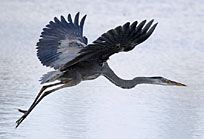 Unlike some herons that actively stalk their prey, Great Blue Herons tend to stand motionless for long periods of time, waiting for unsuspecting food items to swim within striking distance of its sharply pointed eight-inch bill. This big heron usually snaps up small prey crosswise in its bill but tends to skewer larger fish and flip them deftly into the air before re-catching and swallowing them.
Unlike some herons that actively stalk their prey, Great Blue Herons tend to stand motionless for long periods of time, waiting for unsuspecting food items to swim within striking distance of its sharply pointed eight-inch bill. This big heron usually snaps up small prey crosswise in its bill but tends to skewer larger fish and flip them deftly into the air before re-catching and swallowing them.
Although we suspect there may be a heronry not far from Hilton Pond--perhaps on the Broad River 15 miles west of here or along a Catawba River impoundment less than 15 miles to our east--we seldom spot Great Blue Herons during the breeding season. Instead, we most often see their dark profiles silhouetted against the drab winter waters of Hilton Pond. Perhaps if these February birds are not local they have wandered inland from the Carolina Lowcountry and soon will be winging their way back to breeding grounds along the coast.
Great Blue Heron nests--which can be found by the dozens and even hundreds in established heronries--are usually platforms of sticks so loosely stacked that it's often possible to see eggs from beneath. 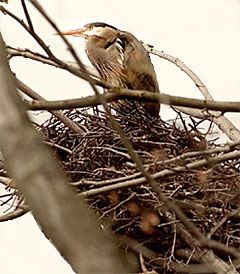 This may be a blessing in disguise, however, since nestling herons aren't particularly fastidious in their habits and a loosely built nest allows fishy-smelling excrement to fall through if youngsters fail to void over the edge. Some herons do line their nest with marsh grass, pine needles, and/or moss; nests of established pairs may eventually reach three or four feet in diameter--and become so heavy that dead branches on which they're built give way beneath them. Clutches range from 3-7 eggs, with four as the average. If Great Blue Herons do breed somewhere near Hilton Pond, we suspect they'll be on eggs as early as the first or second week in March--even earlier than that down in Florida when they have been known to start breeding in November.
This may be a blessing in disguise, however, since nestling herons aren't particularly fastidious in their habits and a loosely built nest allows fishy-smelling excrement to fall through if youngsters fail to void over the edge. Some herons do line their nest with marsh grass, pine needles, and/or moss; nests of established pairs may eventually reach three or four feet in diameter--and become so heavy that dead branches on which they're built give way beneath them. Clutches range from 3-7 eggs, with four as the average. If Great Blue Herons do breed somewhere near Hilton Pond, we suspect they'll be on eggs as early as the first or second week in March--even earlier than that down in Florida when they have been known to start breeding in November.
Great Blue Herons, Ardea herodias, have one of the widest distributions of any New World bird. They breed across Mexico and the U.S., except for mountain ridges and desert areas. In winter they range as far south as Central America and northwestern South America before returning north to nest. Incidentally, the real Gray (Grey) Heron, Ardea cinerea, is found in Europe, Asia, and Africa and is even grayer than our native Great Blue Heron.
Our most intimate contact with a Great Blue Heron came a few years ago when one was reported walking--not flying--through several waterfront yards along the backwaters of Lake Wylie near Belmont NC. 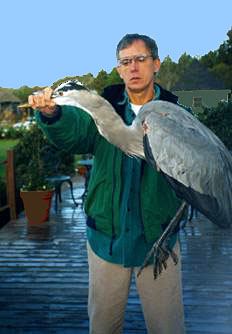 When we went to investigate, we were able to corral a rather emaciated bird whose wing was completely bound up with fishing line left behind by a careless and/or thoughtless and/or malicious angler. Nylon monofilament lasts a long time in the environment and kills far more birds, mammals, turtles, and game fish than folks realize; once a few strands of the fine line wrap around a neck, leg, fin, or wing, only limber animals with sharp teeth can ever hope to loosen themselves from this murderous material. Fortunately, the heron we hand-caught wasn't past saving, so we called a local wildlife rehabilitator who nursed the bird back to health. We include our photo (above left) to illustrate no matter whether you see this bird as blue or gray, a four-foot-tall Great Blue Heron is a great big bird--and one whose bill we clutched tightly lest it spear our eyeball like that of some hapless perch or bream.
When we went to investigate, we were able to corral a rather emaciated bird whose wing was completely bound up with fishing line left behind by a careless and/or thoughtless and/or malicious angler. Nylon monofilament lasts a long time in the environment and kills far more birds, mammals, turtles, and game fish than folks realize; once a few strands of the fine line wrap around a neck, leg, fin, or wing, only limber animals with sharp teeth can ever hope to loosen themselves from this murderous material. Fortunately, the heron we hand-caught wasn't past saving, so we called a local wildlife rehabilitator who nursed the bird back to health. We include our photo (above left) to illustrate no matter whether you see this bird as blue or gray, a four-foot-tall Great Blue Heron is a great big bird--and one whose bill we clutched tightly lest it spear our eyeball like that of some hapless perch or bream.
Tall as it was, the free-flying Great Blue Heron we encountered this week at Hilton Pond apparently wanted an even better view and chose to stand on a Wood Duck box for a couple of hours-- allowing us ample opportunity to admire and capture its regal midwinter profile with our telephoto lens.

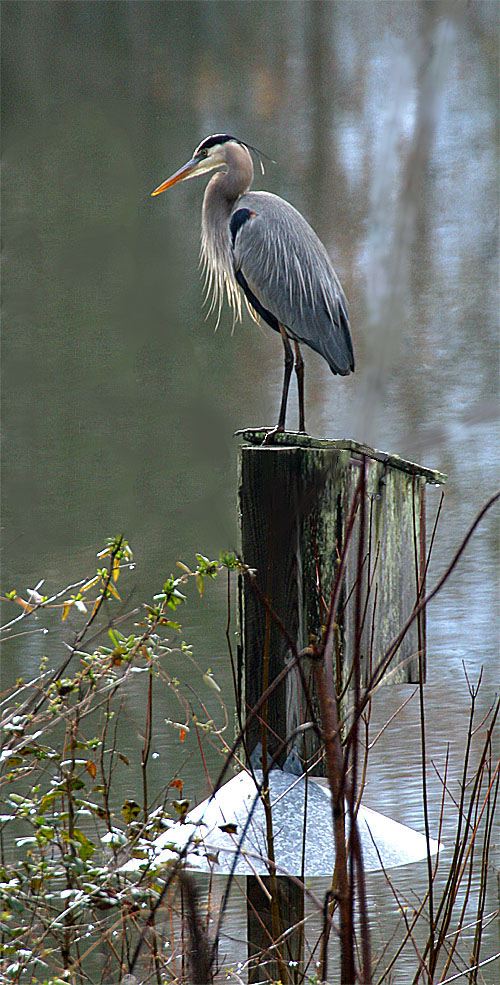
 Although Great Blue Herons are sometimes erroneously called "blue cranes," members of the Crane Family (Gruidae) fly with necks outstretched, while a heron or egret (Ardeidae) folds its neck into an S-shape and holds its head close to the body (above right)--long legs trailing behind as it flaps steadily and strongly. Only at take-off and landing does the heron extend its neck (below left), likely in an effort to maintain balance at those precarious times as it glides through the air on its six-foot wingspan.
Although Great Blue Herons are sometimes erroneously called "blue cranes," members of the Crane Family (Gruidae) fly with necks outstretched, while a heron or egret (Ardeidae) folds its neck into an S-shape and holds its head close to the body (above right)--long legs trailing behind as it flaps steadily and strongly. Only at take-off and landing does the heron extend its neck (below left), likely in an effort to maintain balance at those precarious times as it glides through the air on its six-foot wingspan. Unlike some herons that actively stalk their prey, Great Blue Herons tend to stand motionless for long periods of time, waiting for unsuspecting food items to swim within striking distance of its sharply pointed eight-inch bill. This big heron usually snaps up small prey crosswise in its bill but tends to skewer larger fish and flip them deftly into the air before re-catching and swallowing them.
Unlike some herons that actively stalk their prey, Great Blue Herons tend to stand motionless for long periods of time, waiting for unsuspecting food items to swim within striking distance of its sharply pointed eight-inch bill. This big heron usually snaps up small prey crosswise in its bill but tends to skewer larger fish and flip them deftly into the air before re-catching and swallowing them. This may be a blessing in disguise, however, since nestling herons aren't particularly fastidious in their habits and a loosely built nest allows fishy-smelling excrement to fall through if youngsters fail to void over the edge. Some herons do line their nest with marsh grass, pine needles, and/or moss; nests of established pairs may eventually reach three or four feet in diameter--and become so heavy that dead branches on which they're built give way beneath them. Clutches range from 3-7 eggs, with four as the average. If Great Blue Herons do breed somewhere near Hilton Pond, we suspect they'll be on eggs as early as the first or second week in March--even earlier than that down in Florida when they have been known to start breeding in November.
This may be a blessing in disguise, however, since nestling herons aren't particularly fastidious in their habits and a loosely built nest allows fishy-smelling excrement to fall through if youngsters fail to void over the edge. Some herons do line their nest with marsh grass, pine needles, and/or moss; nests of established pairs may eventually reach three or four feet in diameter--and become so heavy that dead branches on which they're built give way beneath them. Clutches range from 3-7 eggs, with four as the average. If Great Blue Herons do breed somewhere near Hilton Pond, we suspect they'll be on eggs as early as the first or second week in March--even earlier than that down in Florida when they have been known to start breeding in November. When we went to investigate, we were able to corral a rather emaciated bird whose wing was completely bound up with fishing line left behind by a careless and/or thoughtless and/or malicious angler. Nylon monofilament lasts a long time in the environment and kills far more birds, mammals, turtles, and game fish than folks realize; once a few strands of the fine line wrap around a neck, leg, fin, or wing, only limber animals with sharp teeth can ever hope to loosen themselves from this murderous material. Fortunately, the heron we hand-caught wasn't past saving, so we called a local wildlife rehabilitator who nursed the bird back to health. We include our photo (above left) to illustrate no matter whether you see this bird as blue or gray, a four-foot-tall Great Blue Heron is a great big bird--and one whose bill we clutched tightly lest it spear our eyeball like that of some hapless perch or bream.
When we went to investigate, we were able to corral a rather emaciated bird whose wing was completely bound up with fishing line left behind by a careless and/or thoughtless and/or malicious angler. Nylon monofilament lasts a long time in the environment and kills far more birds, mammals, turtles, and game fish than folks realize; once a few strands of the fine line wrap around a neck, leg, fin, or wing, only limber animals with sharp teeth can ever hope to loosen themselves from this murderous material. Fortunately, the heron we hand-caught wasn't past saving, so we called a local wildlife rehabilitator who nursed the bird back to health. We include our photo (above left) to illustrate no matter whether you see this bird as blue or gray, a four-foot-tall Great Blue Heron is a great big bird--and one whose bill we clutched tightly lest it spear our eyeball like that of some hapless perch or bream.

 Oct 15 to Mar 15
Oct 15 to Mar 15
